

2/2006
Midwest Landmark Hotels Get Makeovers to Restore Grandeur

by Russell Boniface
Associate Editor
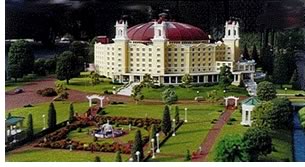 What do architecture and Al Capone have in common?
What do architecture and Al Capone have in common?
Besides both beginning with the letter a, they were once found in abundance in the early 20th century at the historic French Lick Springs Resort Hotel and nearby landmark West Baden Springs Hotel, both in Orange County, Ind., in the towns of French Lick and West Baden, respectively. Orange County is at the southern end of the state and is about a two-hour drive from Indianapolis.
While Mr. Capone, a regular patron of both resorts, will not be returning, the elegant architecture is, thanks to a $320 million joint makeover that will restore both hotels to their earlier turn-of-the-century splendor. Both resorts were once magnificent “out of the way” getaway locations due to their architecture, spas, attractions, and, albeit illegal, gambling. Now, developers are bringing back the original luster of the two grand hotels to form a premier mid-West vacation destination. The centerpiece of the new project will be an 80,000-square-foot casino with 1,000 slot machines, a throwback to the casinos of the 1920s. Beyond that, George Ridgway, AIA, lead architect of the renovation, promises “there will be something for everyone.”
Turning back the architecture clock
Once a playground for the rich in the early to mid-1900s, the towns of
French Lick and West Baden were unparalleled for two things: Pluto
Mineral Spring—which generated water for hot spas—and gambling.
Centered on these attractions were two grand hotels and one large,
posh casino in between known as Brown’s Casino, named after owner
Al Brown.
“In the 1920s it was a hotbed for illegal gambling,” says Ridgway, architect for the Bloomington, Ind.-based Cook Group. “The story goes, if Capone showed up, you would need to read a Chicago paper to see what trouble he was in. Actually, at one time were 27 hotels in the Orange County valley and about eight gambling establishments. The stock market crash put a damper on some of the gambling, and the legislature got nasty with them in the ’30s and shut down all the illegal gambling.”
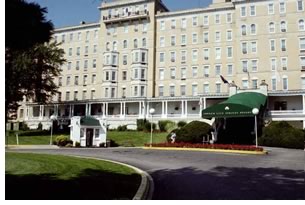 French Lick luxury
French Lick luxury
The French Lick Springs Resort, with its French-style architecture, was
originally built in 1832. After a fire, it was renovated in 1905. The
resort became a popular 471-room resort destination covering 432,000
square feet. The new version was a towering expanse of yellow brick,
steel, and glass, seven floors in all, with the first two veranda floors
wrapping the structure. Inside, scagliola walls and columns lined a
spacious, crystal-chandeliered lobby. Etched archways, softly colored
marble, and gold leaf were all part of the interior design. Outside,
there were red brick walks, a Japanese garden with a miniature lake,
and huge golf courses. It was considered a city within a city, offering
all the amenities, including natural-spring mineral-water spas housed
in a gazebo at the famous Pluto Spring, touted for its healing and
vitality powers.
But, of course, there was that other feature: gambling. Brown’s casino was a short walk from either of the two hotels. Well-known hotel and casino patrons in addition to Capone included “Diamond Jim” Brady; popular movie stars like Lana Turner, Clark Gable, and Bing Crosby; composer Irving Berlin; and boxer Joe Louis. In the French Lick Resort Grande Colonnade Ballroom, Frankin Delano Roosevelt announced his presidential candidacy. A few short years later, he introduced his New Deal Platform there. In 1940, the Chicago Cubs held team meetings and used the property for their spring training site. Much more recently, in French Lick’s Taggert Hall in 1971, Ronald Reagan held his Governor’s Conference, beginning his road to the White House amid the birds, flowers, trees, and sawdust paths that gave the grounds a feeling of serenity. Unlike the West Baden Springs Hotel, the French Lick Springs Hotel never did close.
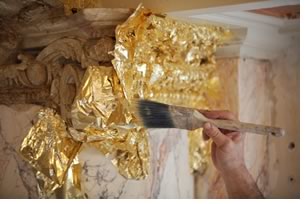 West Baden beauty
West Baden beauty
Looking like a fairy-tale castle, the West Baden Springs Hotel was built
in 1902 and labeled the “Eighth Wonder of the World.” The
West Baden Springs Hotel features a six-story domed atrium, the largest
clear-span dome in the world until the Astrodome was built in 1963.
There were 700 rooms, natural mineral springs for spas, and, like French
Lick, all the amenities, including the gambling at Brown’s Casino
and celebrity sightings. Professional baseball teams, such as the Chicago
White Sox and Cubs and the Cincinnati Reds, held spring training on
the baseball field located on the 250 acres that made up the property.
In 1934, the Jesuits took over the property and, over time, altered
the structure, removing much of its original ornamental design. Later,
a hotel management and culinary arts school made the building its home
until 1983. Over the next 13 years, the property was idle. Weather
and time took its toll.
In 1904 a trolley line was constructed that linked both the French Lick and West Baden hotels. Both are listed on the National Register of Historic Places. West Baden Springs, however, is a National Historic landmark, which gives it higher status, and, in 1999, it won the National Historic Landmark award given by the Civil Engineering Society.
Making a French re-connection
Blue Sky Casinos and Resorts is the operating entity of the renovation
of the French Lick and West Baden hotels and is a partnership of the
Cook Group and Indianapolis-based Lauth Construction. Between 1996
and ’99, the Cook group spent $37 million working on the West
Baden Springs, although the hotel is still owned by the Historic Landmarks
Foundation in Indianapolis. The Cook Group, however, will acquire it
and complete the restoration of the West Baden Springs once the title
of it is transferred to Blue Sky. The Cook Group purchased French Lick
last April for $25 million. Charles Frank Charles (CFC), the Cook Construction
company, is in charge of building. Benchmark Hospitality will be the
hotel operator for both hotels.
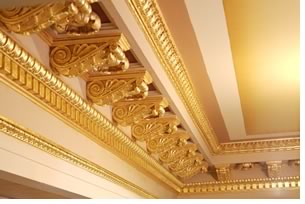 “The Cook Group is the major benefactor for this project,” says
Ridgway. “Bill and Gayle Cook and their son Carl are unbelievable
activists when it comes to historic preservation.” The Cook Group
is the world’s largest privately held medical-devices manufacturer.
“The Cook Group is the major benefactor for this project,” says
Ridgway. “Bill and Gayle Cook and their son Carl are unbelievable
activists when it comes to historic preservation.” The Cook Group
is the world’s largest privately held medical-devices manufacturer.
Ridgway says French Lick is very impressive architecturally. “The hotel is a very eclectic building,” says Ridgway. “It has some elements of the Beaux Arts style, as well as Classical proportion on the inside columns, especially in the elaborate marble lobby.
“There is also Roman brick, which was actually called French Lick brick.” Construction is well under way at both French Lick and West Baden. When complete, French Lick will have 444 guest rooms and suites, elaborate fine dining restaurants, bistros, and 11 commercial kitchens. The first phase of the project—renovating the rooms at the French Lick Springs Resort and building the casino—began last July and is scheduled to be finished by December 2006. Eggshell white paint in the lobby has been already removed on the columns to reveal scagliola. On the lobby’s ceiling, workers have found that many of the architectural elements are gold-leafed. Workers also found that many of the tray ceilings have small light fixtures in what appears to be rosettes that have been painted over. Ridgway says there are probably 200-250 of the light fixtures, which are being rewired and restored to their original function. So far, 15,000 white and 7,000 to 8,000 colored tiles have been replaced.
The French Lick Springs Casino’s design will mirror the resort’s French-style architecture. A single floor will incorporate Las Vegas influences, such as 26-foot ceilings, new state-of-the-art slot machines, and upscale amenities. Earthwork, caissons, and foundations are complete. Steel erection is 95 percent complete. “This is not just another little casino project in Indiana,” stresses Ridgway. “It is a very large and impressive project. We are not looking at making an Indiana resort, we are looking for a major Midwestern resort. This property is over 3,000 acres, and we are going to be open come December. The French Lick will maintain its three-star status, but the 80,000-square-foot casino will be a high-end, four-star casino for high rollers. It will all be a very memorable structure.”
 The hotel’s suspended ceilings are being removed, and the spa
area, piping in the water from the Pluto Mineral Spring, will also be
getting an upgrade. The spa, which was built in 1905, boasts one-inch-thick
marble walls, which, in some areas, will be reconfigured for the new
spa layout. Stained glass windows will also be repaired. Future renovation
of the spa will be similar to the lobby, where layers of paint and wallpaper
will be removed for restoration. Workers have already removed paint from
brick walls to reveal white glazed brick.
The hotel’s suspended ceilings are being removed, and the spa
area, piping in the water from the Pluto Mineral Spring, will also be
getting an upgrade. The spa, which was built in 1905, boasts one-inch-thick
marble walls, which, in some areas, will be reconfigured for the new
spa layout. Stained glass windows will also be repaired. Future renovation
of the spa will be similar to the lobby, where layers of paint and wallpaper
will be removed for restoration. Workers have already removed paint from
brick walls to reveal white glazed brick.
Changes are also planned for the Grand Colonnade Ballroom, which will be the hotel’s new fine buffet dining room. The Pluto Dining Room, which overlooks the current pools, will also be refurbished. The pools will be replaced with two new ones, built on the south side of the building. The new 109,000-square-foot events center, which will accommodate concerts and other business and entertainment, will be two stories tall, include a finished basement, and be designed with the same architectural details as the hotel. Its earthwork and caissons are complete, and foundations are 50 percent complete. Steel erection is scheduled for early February.
“There will be plenty of amenities,” says Ridgway. “There will be two 18-hole PGA golf courses being restored to their original design from 1920, horse riding trails and stables, golf, tennis, bowling, dining, swimming, and a shooting range, in addition to the events and conference center. There will be something there for everybody.”
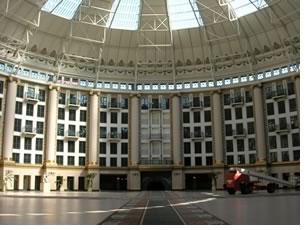 Tea and scones under the dome
Tea and scones under the dome
Blue Sky and Historic Landmarks will resume restoration of West Baden
Springs this month. By July 2007, for the first time since 1932, West
Baden Springs will offer overnight accommodations—this time in
244 guestrooms and suites. The resort will encompass 236,000 square
feet when complete. West Baden Springs is most noted for its six-story
atrium capped with its enormous dome. West Baden will be turned into
a four-star hotel with similar amenities to French Lick. Its six story,
clear span domed structure, 200 feet in diameter and 100 feet in height,
built in 277 days in 1902, has 12,000 square feet of glass skylights
and is larger than either the St. Peter Basilica or the Pantheon.
Visitors can still tour the historic building and get to see the beautiful dome. The main floor has been renovated, but the concrete skeleton is evident. “We started a restoration of all the public spaces of the West Baden hotel in 1996,” says Ridgway. However, the sixth floor was already restored: six elegantly decorated rooms complete with furniture, left behind after Donald Trump was awarded the bid to build the casino but later pulled out. In one section, there is a tea room in front of the largest suite, which features a living room and kitchen. On February 11, the West Baden hosted a special five-course gourmet Valentine’s Tea on the floor, replete with scones, muffins, lemon curd, and dainty finger sandwiches. This perhaps would not have appealed to Al Capone, but the event was well-received as a way to encourage community enthusiasm.
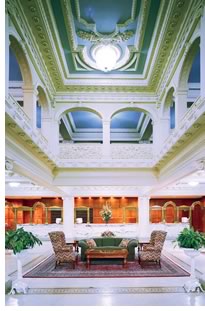 Revitalizing the French Lick and West Baden communities
Revitalizing the French Lick and West Baden communities
The community will indeed benefit from the restoration. The entire project,
thanks in large part to winning the gambling license last July, is
expected to rejuvenate the financially poor area to the vibrancy of
a playground for the rich and famous. “This is a truly historic
step forward for the people of Orange County and the rest of the state,” said
Steve Ferguson, chairman of Cook Group. “By approving this gaming
license application, the Indiana Gaming Commission has put the final
piece of the economic development puzzle in place for an area that
has long suffered high unemployment and a lowered standard of living.”
The casino project alone is estimated to create about 1,400 jobs and provide an estimated $32 million in annual salaries and benefits between the two resorts. The casino itself will generate an estimated $32.6 million in annual admission and gaming tax revenue, as well as $3.2 million annually in local incentives. Ridgway adds that 200 Orange County construction employees are currently involved in the huge project. “It is a boon to their economy, and it will continue to be that way.”
Lauth Group CEO Robert Lauth agrees: “With this approval, we have a unique opportunity not only to revive two of this nation’s most historic resorts, but also to bring economic vitality to the French Lick area.”
And for vitality, it never hurts to have a little Pluto Spring water nearby.
Copyright 2006 The American Institute of Architects.
All rights reserved. Home Page ![]()
![]()
Did you
know . . .
French Lick was originally a French trading post. The town was founded
in 1811.
West Baden was named after Wiesbaden, Germany, also a mineral spring community.
Pluto Water was bottled at French Lick, hence the Pluto Dining Room, Pluto Spring gazebo, and the hotel’s Pluto Bar, an ornate serving counter located off the lobby that served hot or cold water piped directly from the spring.
After drinking the waters at French Lick, it was recommended that some form of moderate exercise be taken. A favorite walking place was called the “track,” a third-of-a-mile path through shady forests.
Tomato juice as we know it today was invented in 1917 at the French Lick. Chef Louis Perrin created tomato juice as a breakfast beverage after he discovered one morning that he had no oranges for orange juice.
Hundreds of hotel guest would leave the hotel in the evenings and visit Brown’s casino. The casino offered roulette, blackjack, and all forms of gambling.
Consuming—or bathing in—mineral waters was once referred to as taking the waters or taking the cure.
Basketball star Larry Bird was born in French Lick, attended school there, and now resides there.
![]()